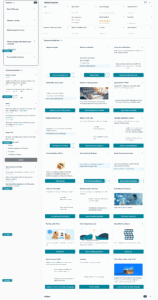
The redesigned Seller Central homepage is evolving into a more effective operational hub, placing critical data like Account Health and simplified alerts front and center to help you manage your business more directly.
For years, Amazon sellers have juggled multiple reports and expensive third-party tools to get a clear picture of their business performance. The standard Seller Central interface often felt disconnected, making deep data analysis a time-consuming challenge.
As of the first quarter of 2025, more than 2.5 million active sellers are competing across Amazon’s global marketplaces. In such a crowded environment, making slow, uninformed decisions means losing ground to competitors who can react faster.
In a significant move to address this, Amazon has launched a completely redesigned Seller Central homepage and a powerful new “Custom Analytics” feature. These updates provide sellers with the business intelligence tools needed to make smarter, data-driven decisions directly within Amazon’s own platform.
A Closer Look at the New Seller Central Homepage
Amazon has rolled out a redesigned Seller Central homepage aimed at giving sellers more clarity, control, and convenience. This updated interface is being introduced gradually, with an option to switch between the new and previous versions during the transition.
One of the most noticeable changes is the relocation of account health status to the top of the page. Sellers can now view a summary of account health across all their stores at a glance.
This section includes a clickable breakdown that leads directly to the Account Health page. There, sellers can pinpoint issues and take corrective action to maintain account compliance.
A new store selector lets sellers filter which stores appear in the health overview. This customization gives sellers the flexibility to prioritize the storefronts that matter most.
The action center has also been simplified with a clearer layout and improved language. Alerts are still prioritized, helping sellers manage orders, track shipments, and resolve urgent issues efficiently.
Several additional features are slated for release in the coming months. Among them is a Business Performance chart designed to surface key trends in sales, orders, sessions, and conversion rates.
Sellers will also gain visibility into how their most important ASINs perform directly from the homepage. These updates aim to bring more relevant metrics front and center—without the need to dig through reports.
Key highlights of the updated homepage include:
Account Health Summary
Quick view across all stores, with drill-down capability
Store Selector
Focus on specific stores for a tailored overview
Simplified Action Center
Cleaner alerts and task prioritization
Business Performance Chart (coming soon)
Track performance trends over time
Top ASIN Performance Monitoring (coming soon)
See critical product metrics at a glance
My Amazon Guy"It’s not just about managing products; it’s about strategically positioning your listings for maximum visibility and sales."
Understanding the Seller Central Homepage
The Seller Central homepage serves as the main dashboard for Amazon sellers, combining business metrics, account alerts, and actionable insights in one location. It is designed to adapt to each seller’s stage in the business lifecycle, surfacing the most important tasks and data first.
This seller central hub is continuously being improved based on seller feedback, with new features rolled out in a way that minimizes disruption. Amazon is committed to transparency as changes are implemented, so sellers always know what to expect.
Key Performance Indicators (KPIs) form the backbone of the homepage’s business reporting section. These metrics help sellers evaluate business performance and support smarter, data-driven decisions.
- Sellers with multiple storefronts can filter KPI cards by store, time range, and currency.
- Most metrics update in real time, but some may take up to one hour.
- Currency conversion data is for reference only and may not reflect final earnings or fees.
The homepage also includes an Actions section that helps sellers stay on top of urgent and routine tasks. These action cards are categorized by alert type:
- Red Alerts
Immediate attention required – includes suspensions, deactivations, and major account disruptions. - Yellow Alerts
Warnings of possible risk, such as product listing issues or account compliance threats. - General Actions
Day-to-day operations, such as managing open returns, resolving shipment issues, or restocking FBA inventory.
Below the actions list, the Recommendations section offers optional guidance for improving sales, listings, and customer satisfaction. These suggestions are personalized and can help sellers identify opportunities they may have overlooked.
The Communications section keeps sellers informed about updates from Amazon, seller forums, and community announcements. This space ensures sellers don’t miss important platform-wide updates.
Sellers can personalize their homepage layout by hiding cards that aren’t immediately useful. Clicking the three-dot menu on a card allows the seller to move it to the hidden section or provide feedback about its relevance.
- Cards labeled “temporarily hide” will return after 7 days.
- Hidden cards can be restored at any time from the Hidden Section.
The feedback module lets sellers rate and comment on individual cards throughout the homepage. It includes:
- A five-star rating scale for quick feedback
- Category selection to tag the type of feedback
- A comment box for optional suggestions (excluding personal information)
This tool supports Amazon’s goal of building a seller-centric homepage by actively collecting and responding to seller input. It allows the homepage to evolve based on what real users find most valuable.
Maximizing the New Seller Central Homepage
To get the most value from the updated Seller Central homepage, you should actively integrate its new features into your daily workflow. Adopting a few new habits can turn the homepage into a more powerful tool for managing your business.
Make It Your Daily Check-in
Start each day by reviewing the new Account Health and Action Center widgets first. This allows you to get a complete overview of your business’s immediate standing before you do anything else.
Check Account Health
Make it a habit to check your account health status across all stores for any warnings.
Clear Urgent Tasks
Address any prioritized alerts in the action center to prevent them from becoming larger issues.
Customize Your View for Efficiency
Use the new customization options to focus only on the information that is most relevant to you. A tailored view helps you spot important trends and issues in your key markets faster.
Use the Store Selector
Tailor your Account Health view to focus on your most important or problematic stores.
Prepare for New Widgets
As new performance charts and product monitoring tools arrive, plan to place them prominently on your homepage.
Engage with the New Tools
Actively use the new features as they roll out instead of relying only on your old methods. The goal of the update is to bring key metrics and actions into one place to save you time.
Drill into Details
Click through from the homepage widgets to the detailed pages to address issues directly.
Provide Feedback
Use the feedback options and switch between the old and new versions to help Amazon build a homepage that works best for your needs.
Amazon Also Launched Custom Analytics
Another significant update on Seller Central was shared on LinkedIn by Isaac Gross: Amazon has launched Custom Analytics, a powerful new feature that brings business intelligence capabilities directly into Seller Central. Designed to give sellers full control over performance data, this update allows for flexible, dashboard-level reporting without relying on third-party tools.
Custom Analytics lets sellers build their own dashboards by selecting from hundreds of available metrics across nearly every area of their Amazon business. These include data from reports such as:
- Inventory
- Coupons
- Search Query Performance
- Sales performance
- Fulfillment and operations
Sellers can either start from scratch or use pre-built templates offered by Amazon. This flexibility allows new and experienced sellers alike to surface the data they care about most.
Dashboards can be tailored to highlight specific KPIs, product segments, or marketplace activity. This helps sellers focus on what’s driving growth—or holding it back—without switching between multiple reports.
With the layout and feel similar to business intelligence platforms like Tableau or Power BI, Custom Analytics marks a major shift in how sellers interact with their data. The goal is to support faster, better-informed decision-making using real-time insights.
The release of this feature shows Amazon’s growing focus on giving sellers more autonomy and precision when it comes to managing their business performance. As more sellers explore its capabilities, Custom Analytics is expected to become a central tool in many account strategies.
A Closer Look at What Sellers Can Do with Custom Analytics
The new Custom Analytics dashboard offers a remarkable level of detail and customization that many sellers have wanted for years. To provide more detail, Noah Wickham, our Amazon agency’s VP of Sales and Marketing, delved into this new Seller Central feature in the video below.
Accessing and Using the Dashboard
Sellers can find this new tool by navigating to the “Reports” tab in Seller Central and then selecting “Custom Analytics.” Once there, you have two primary options for getting started.
You can begin with a pre-built template or create a completely new dashboard from a blank slate.
Available templates include:
- Prime Day Recap
- Coupons, Deals, and Discounts
- Sales and Pricing
- Traffic and Sales
A Powerful Alternative to Third-Party Tools
This new feature is widely seen as a major step up, providing data and insights that are as good as, if not better than, many third-party reporting services. While it may not eliminate the need for all external software, it significantly narrows the gap.
The tool finally gives sellers the ability to utilize years of their own data in a flexible and powerful way. This access to information directly within Seller Central is a long-overdue but very welcome improvement.
Building Your Own Custom Reports
The true power of the dashboard lies in the ability to create custom reports from scratch. Sellers can build multi-year trend reports and add a vast number of data tiles.
The feature is useful for both FBA and FBM sellers, with available metrics including:
- Order Count
- Late Shipment Rate
- On-Time Delivery Rate
HashStudioz Technologies"Companies with custom analytics solutions report a 25% increase in operational efficiency on average."







